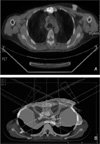Abstract
Breast cancer has become one of the most frequent malignancies among Korean women and the role of radiation therapy (RT) is expected to increase continuously. Current concepts in the treatment of breast cancer include a less radical surgery and the emergence of RT and systemic drug treatment. A surgery directed to minimize breast loss and RT to the whole breast has been the treatment of choice for early lesions. The use of whole breast irradiation (WBI) after the minimal breast surgery has been shown to significantly reduce the risk of recurrence in the affected breast and to increase the likelihood of long-term survival. Recently, there has been growing interest in the use of accelerated partial breast irradiation (APBI) as an alternative to WBI. APBI offers decreased overall treatment time and several advantages over WBI, including a decrease in the radiation dose delivered to uninvolved breast and adjacent organs. For the radiotherapy of breast cancer virtual simulation using the CT for three dimensional conformal RT has been widely used for external radiotherapy. The interstitial brachytherapy (insertion of radioactive source into the breast), balloon brachytherapy, and intraoperative electron therapy has been used for the APBI. Three dimensional radiotherapy including intensity modulated radiotherapy will be more widely used for breast cancer. RT fields are progressively reduced and APBI will be a realistic alternative in the future. Conclusion: The role of RT for treatment of breast cancer is important and the implementation of new RT technology will increase.
Figures and Tables
Figure 2
(A) Sternal metastasis of breast cancer showing hot spot on PET/CT.
(B) 3-Dimensional Conformal Radiation Therapy planning for metastatic sternal lesion.

Figure 3
Advanced Breast cancer treated with tomotherapy, showing the radiation dose conformal to the mass with minimal dose to lung and heart.

References
1. Ahn SH, Yoo KY. Korean Breast Cancer Society. Chronological changes of clinical characteristics in 31,115 new breast cancer patients among Koreans during 1996-2004. Breast Cancer Res Treat. 2006. 99:209–214.

2. Son BH, Kwak BS, Kim JK, Kim HJ, Hong SJ, Lee JS, Hwang UK, Yoon HS, Ahn SH. Changing patterns in the clinical characteristics of Korean patients with breast cancer during the last 15 years. Arch Surg. 2006. 141:155–160.

3. Ahn SH. Nationwide Korean Breast cancer data of 2008. 2009. In : 2009 Seoul Breast Cancer Symposium; Seoul. 2–22.
4. Ji YH, Kim MS, Yoo SY, Yoo DH, Choi MS, Chung HJ. Statistics of radiation oncology in Korea in 2006. J Korean Soc Ther Radiol Oncol. 2008. 26:131–133.
5. Clarke M, Collins R, Darby S, Davies C, Elphinstone P, Evans E, Godwin J, Gray R, Hicks C, James S, MacKinnon E, McGale P, McHugh T, Peto R, Taylor C, Wang Y. Early Breast Cancer Trialists' Collaborative Group (EBCTCG). Effects of radiotherapy and of differences in the extent of surgery for early breast cancer on local recurrence and 15-year survival: an overview of the randomised trials. Lancet. 2005. 366:2087–2106.

6. Vinh-Hung V, Verschraegen C. Breast-conserving surgery with or without radiotherapy: Pooled-analysis for risks of ipsilateral breast tumor recurrence and mortality. J Natl Cancer Inst. 2004. 96:115–121.

7. Kim KJ, Huh SJ, Yang JH, Park W, Nam SJ, Kim JH, Lee JH, Kang SS, Lee JE, Kang MK, Park YJ, Nam HR. Treatment results and prognostic factors of early breast cancer treated with a breast conserving operation and radiotherapy. Jpn J Clin Oncol. 2005. Mar. 35:126–133.

8. Smith BD, Arthur DW, Buchholz TA, Haffty BG, Hahn CA, Hardenbergh PH, Julian TB, Marks LB, Todor DA, Vicini FA, Whelan TJ, White J, Wo JY, Harris JR. Accelerated partial breast irradiation consensus statement from the American Society for Radiation Oncology (ASTRO). Int J Radiat Oncol Biol Phys. 2009. 15. 74:987–1001.

9. Fisher B, Anderson S, Bryant J, Margolese RG, Deutsch M, Fisher ER, Jeong JH, Wolmark N. Twenty-year follow-up of a randomized trial comparing total mastectomy, lumpectomy, and lumpectomy plus irradiation for the treatment of invasive breast cancer. N Engl J Med. 2002. 347:1233–1241.

10. 0413 broadcast. Radiation Therapy Oncology Group. Accessed December 23, 2008. Available at:
www.rtog.org/members/protocols/0413/0413broadcast.html.




 PDF
PDF ePub
ePub Citation
Citation Print
Print





 XML Download
XML Download